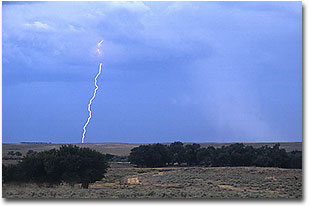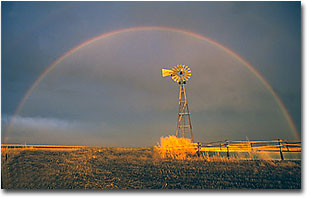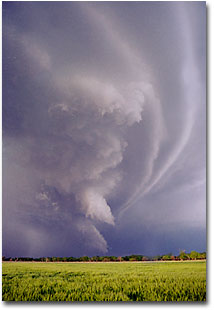|
|
 Summer Storm Photography
Text and photography Copyright Gary Thomas
Growing up in southwest Kansas, the weather has always been a big part of my life. When I was five years old, I experienced my first tornado. The funnel was less than five miles from my grandmother’s house. To this day, I still remember the excitement and wonderful beauty of that funnel. Since then I have observed from a distance, and even been a little intimidated by, the enormous power of thunderstorms that roll across the plains. This all changed three years ago while photographing birds at a lake. I was caught by a swift moving storm and as it cleared, the light glowed in ways I never noticed before. Slowly I started chasing more and more, learning everything I could about the weather, experimenting with exposures and film. Today weather photography is one more way I can express myself artistically, and experience the power of nature at its best. Here in southwest Kansas storms are like the birds in Florida; they just seem to jump in front of the lens. But even with a storm right in front of me, I have to learn to read the weather, choose the right equipment, the right film, and to stay safe. All of these issues have to be dealt with while trying to stay in position along with the storm, driving, reading a map and loading film, and so on and so on. I have no formal training in weather. Everything I have learned is from the web and friends who are trained or are certified spotters. Any questions you might have can be answered by your local NOAA station. They love talking about the weather and giving information. First and foremost, safety is a big issue for me. Remember no storm photo is worth your life. Storm chasing is a very exciting hobby, but it can get dangerous at times. These risks can be minimized by educating yourself and to always remember that you can break off a chase at anytime and use a longer lens. Lightning, while it is the most impressive on film, can be the most dangerous. If you can see the storm, you can be hit by lightning. The safest way to photograph lightning is from a vehicle. While this may be the safest, it is not foolproof. I use a window mount to attach my camera, and try to stay a distance away choosing to use a longer lens. Common sense is the best rule. While I was chasing a tornado last year’ another chaser almost hit me from the rear because he was too busy looking at the Doppler on his lap top. All he really had to do was look outside his car window and he would have seen the funnel touching down.
I consider storm chasing as another form of landscape photography, so this means I have to scout out photo opportunities well in advance. I keep a log and a map of these locations. This way I have a spot to go to and have an idea of the terrain and the photo opportunities in the area. I try to keep most of my chases within a two hour drive of my house. Storm waiting is more of my technique. I will watch the radar and the way the storm is building and then, wait for it to come to me rather than spend a lot of time driving. One reason I enjoy storm photography so much, is the way a storm changes and allows me capture on film everything from lightning to the rainbow at the end of the storm. Looking at my slides, I can reproduce the entire storm in the order it took place. While it's hard to describe in detail each facet of techniques used in this short article, I will touch on three of them; lightning, tornadoes, and the storm break up.
I have come to enjoy the breaking up of the storm the most. The sun starts to break through; the wind dies down, the meadowlarks start letting me know the world hasn't come apart. Drops of rain form on barbed wire along wheat fields and the fresh breeze of spring fills my heart with a smile. This is the excitement I look forward to when chasing a storm. I find that the storm break up is the most photogenic. The sun is usually low in the horizon bouncing off of the rain, showing off wonderful colors of the rainbow, backed by the dark blue gray of the passing storm. Storm photography, like most nature photography, requires a certain amount preplanning. Choosing the right equipment and knowing what the weather is going to do are among the most important. I have some of the most wonderful memories of chasing storms and have been humbled by most, if not, all of them. GT - NPN 386 Comments on this article? Send them to the editor. |
|
|

 I try to keep the equipment simple. A tripod is
always an essential item. With the wind and
excitement, camera shake really shows up. I hang
something heavy on the tripod to keep the wind shake
down. For my long exposures at night, I use a K-1000
with a 28-80 lens and a cable release. This camera is
reliable, and the controls are easily found in the
dark. My main set up is a Canon EOS 5. The lens I
have on it most of the time is my 28-80 Canon. This
allows me to zoom in if I need to and also, get the
wide angle shots. For lightning, I use my 70-210 Canon
lens. It allows me to get a little farther back from
the action. I also use my 400mm Tokina as a way to
compress the image; it will make the clouds appear
closer to the subject. Film is a big factor in getting
good results, which is why I use a variety. For
lightning at night, I use Velvia 50; when the sky is
overcast, I use Kodak extra color 100. The main film I
use is Sensia 100. I have found it gives me the best
results. Photography equipment is not all that needs
to be brought along. I rely on my NOAA storm alert
radio. It will keep you alerted in changes in the
storm patterns and forecast for cities and counties
that will be affected by these changes. One can be
picked up for under $30.00. A good map is also essential,
especially one that has county roads on it.
Most of the time, I am on dirt roads and backcountry
roads. I also carry a cell phone, mainly so I can
call my friends that are working and let them know how
much fun I am having! Also, family members like to hear
from you. This last one was found out the hard way.
Fill the tank with gas, don't wait until you are
looking a golf ball size hail coming your way to find
out you have very little gas.
I try to keep the equipment simple. A tripod is
always an essential item. With the wind and
excitement, camera shake really shows up. I hang
something heavy on the tripod to keep the wind shake
down. For my long exposures at night, I use a K-1000
with a 28-80 lens and a cable release. This camera is
reliable, and the controls are easily found in the
dark. My main set up is a Canon EOS 5. The lens I
have on it most of the time is my 28-80 Canon. This
allows me to zoom in if I need to and also, get the
wide angle shots. For lightning, I use my 70-210 Canon
lens. It allows me to get a little farther back from
the action. I also use my 400mm Tokina as a way to
compress the image; it will make the clouds appear
closer to the subject. Film is a big factor in getting
good results, which is why I use a variety. For
lightning at night, I use Velvia 50; when the sky is
overcast, I use Kodak extra color 100. The main film I
use is Sensia 100. I have found it gives me the best
results. Photography equipment is not all that needs
to be brought along. I rely on my NOAA storm alert
radio. It will keep you alerted in changes in the
storm patterns and forecast for cities and counties
that will be affected by these changes. One can be
picked up for under $30.00. A good map is also essential,
especially one that has county roads on it.
Most of the time, I am on dirt roads and backcountry
roads. I also carry a cell phone, mainly so I can
call my friends that are working and let them know how
much fun I am having! Also, family members like to hear
from you. This last one was found out the hard way.
Fill the tank with gas, don't wait until you are
looking a golf ball size hail coming your way to find
out you have very little gas. I have found that lightning has a rhythm to it, so I
like to position myself parallel to the storm, prefocus
on my subject and watch for the lightning strikes to
show you their pattern. Most of the time, this pattern
shows up before it gets to your subject, so all you
have to do is be ready. At night, I open my lens up
and use 30 second exposures to capture my image. I
like to use the lightning to silhouette subjects.
Filters can also be used to create different colors of
lightning. Lightning likes tall structures-
buildings, trees, hilltops, just about anything with height can
be used. Chasing tornados is a different ballgame all
together. Tornados are not usually my goal-they are
like the icing on the cake. The tornado chasers like
to be on the southeast side of the storm. This allows
the best vantage point. Thunderstorms rotate in a
counterclockwise formation. It is near the back
downdraft area of the storm that tornados are more
likely to be seen. For the most part this is the
southeast side. Tornadoes are extremely dangerous
and the best advice I have for chasing these beasts is
to meet with people who have experience in chasing
them.
I have found that lightning has a rhythm to it, so I
like to position myself parallel to the storm, prefocus
on my subject and watch for the lightning strikes to
show you their pattern. Most of the time, this pattern
shows up before it gets to your subject, so all you
have to do is be ready. At night, I open my lens up
and use 30 second exposures to capture my image. I
like to use the lightning to silhouette subjects.
Filters can also be used to create different colors of
lightning. Lightning likes tall structures-
buildings, trees, hilltops, just about anything with height can
be used. Chasing tornados is a different ballgame all
together. Tornados are not usually my goal-they are
like the icing on the cake. The tornado chasers like
to be on the southeast side of the storm. This allows
the best vantage point. Thunderstorms rotate in a
counterclockwise formation. It is near the back
downdraft area of the storm that tornados are more
likely to be seen. For the most part this is the
southeast side. Tornadoes are extremely dangerous
and the best advice I have for chasing these beasts is
to meet with people who have experience in chasing
them.